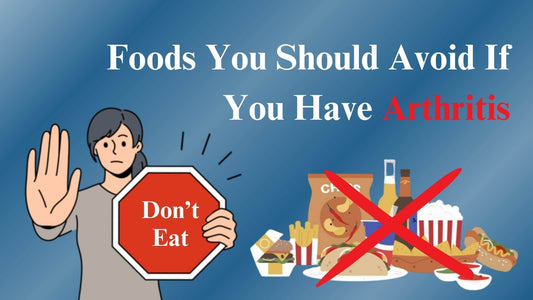
Avoid These 12 Foods for Better Arthritis Management
There are nearly 150 disorders arising in joints, muscles, tendons, and ligaments related to arthritis.
No specific diet or medication can fully cure arthritis. Conditions of arthritis can be reduced or managed to a certain extent with a fiber-, calcium-, and vitamin-enriched diet, especially vitamin D, which is more important for the strengthening of bones and joints.
One must be highly alert about certain food items that may degenerate arthritis conditions.
Understanding Inflammation and Arthritis
Injury and infection in any part of the body or joints lead to inflammation. The affected area becomes red and swollen.
People may get inflamed joints and muscles from any arthritis, which may be for a short period or go on for a long time.
Under any arthritis condition, whether it is osteoarthritis (cartilage degeneration) or rheumatoid arthritis (inflamed synovial membrane), a person feels stiffness, sprains, strains, and cries in pain, finds difficulty bending the specific area, and struggles with mobility.
Some causes of joint pain:
- Injury
- Infection
- Inflammation
- Cartilage degeneration
- Inflamed synovial membrane
Foods You Should Avoid If You Have Arthritis
1. Sugar and Carbohydrates
Consumption of sugar or sugary beverages, and carbohydrates like white rice, potatoes, bread, and crackers can raise the risk of arthritis conditions by not letting the blood flow through the joints so easily in the body.
Drinking unsweetened drinks like fresh lime or green tea and eating a low-carb diet like millet, buckwheat, and barley would be a better option and beneficial for joint health.
2. Red Meat
This form of non-vegetarian dish is high in saturated fats, which may further increase the inflammatory conditions in joints and bones. It may invoke more pain, swelling, and discomfort in the joints.
Rather, substituting lean meat products like chicken, fish, eggs, and vegetarian proteins like legumes and nuts will nourish the joints, enhance lubrication, and stop cartilage degeneration.
3. Heavy-Fat Dairy Products
Drinking high-fat milk or consuming any dairy products like paneer, yogurt, or any other dairy products added with sugar can increase the risk of inflammation, pain, and swelling.
Such dairy products would not go well with someone suffering from obesity and arthritis symptoms. There are also low-fat options in the dairy, which may be kefir and yogurt.
The abundance of gut bacteria in low-fat dairy products shows improvement in joint conditions.
4. Omega-6 Fatty Acids
Cooking with corn oil or soybeans will be a threat to joint mobility and lubrication. These oils are high in omega-6 fatty acids, which are responsible for raising all types of discomfort responses in joints.
Rather, any orthopedic expert would recommend having omega-3 fatty acids in your diet, found in fish rich in natural oils.
Vegetarians can source this specific essential Omega 3 fatty acid by eating flaxseeds, walnuts, and chia seeds to prevent blood clotting or any form of sensitivity in joints.
5. Salt
Similar to sweets and carbohydrates, salt is also a threat to joints, bones, and their connected tissues and muscles.
Most of the packaged food items have salt, and people usually go for those packaged items to satisfy their taste buds.
But none of the salted food items are reliable sources of nourishment for joints, bones, muscles, and connective tissues.
You can improve the flavor of your food items with alternative measures like ground powders of black pepper, cumin, garlic, and onions, or simply rock salt.
Such flavors will not only attract your taste buds but also calm down the nerves and connective tissues in joints and bones.
Try Dhurandar Oil for Joint, Arthritis pain relief
6. Fried Food Items
Eating fried food items would again be a threat to your joint and bone conditions.
It is high enough in trans fats and omega-6 fatty acids, which do not go well with anyone suffering from arthritis. Such fried items and baked products may increase the burning sensation, swelling, and pain.
Instead of getting hooked on any fried food item, one should have salads rich in onions, lettuce leaves, garlic, beetroot, and carrots, seasoned with black pepper and rock salt.
7. Processed and Canned Food Items
You may be easily drawn towards eating cookies, pastries, chowmein, pasta, burgers, bacon, sausages, and even tinned soups and vegetables preserved in different preservatives.
Such items high in sugar, additives, and trans fats may influence joint flexibility and lubrication with inflammation, stiffness, and other negative responses.
To keep the joints healthy and active, it is always safe to depend on any homemade curry cooked with pain-relieving turmeric, cinnamon, garlic, ginger, and black pepper, served fresh and hot.
8. Alcohol
Drinking alcohol regularly may trigger inflammatory conditions in the joints and bone issues. Beer, whiskey, distilled liquor, or wine have high percentages of purines, which may not go well with anyone who suffers from acute joint weakness.
It causes the formation of inflammatory uric acid in the joints which weakens the synovial membrane and lowers lubrication and immobility.
Replacing alcohol with green tea and turmeric milk will be one of the appropriate lifestyle changes to ease joint pain naturally.
9. Sour Food
Eating sour food items like tomatoes and citrus fruits and consuming vinegar may raise the inflammatory response in joints.
Because of the acidic content of such food items, an imbalance rises in the pH level, and that makes the person suffer severely from joint pain.
Sour pickles and fermented products often consumed in a regular diet release histamines, which cause pH imbalance and cartilage loss in the body.
10. Candies and Desserts
Candies and desserts may be high in artificial sweeteners, which may not suit someone who is diabetic. Such sweet items not only cause a spike in sugar levels but also raise the inflammatory condition of the joints and bones.
Instead, selecting berries, Greek yogurt, dark chocolate, honey, and nuts in place of candies and desserts would be better choices for satisfying sweet cravings, nourishing joints and bones, and boosting immunity.
11. Gluten
Gluten would be a rather unfriendly diet for anyone suffering from chronic joint pain or inflammatory arthritis. It is present in wheat and barley, which may increase sensitivity, pain, and tenderness in the joints.
It causes gut leakage, leading to the entry of inflammatory compounds into the bloodstream and the destruction of joints and muscles.
Selecting flours of almond, coconut, or oat, rice, buckwheat, and quinoa would not only ease digestion but not let inflammatory conditions in joints rise any further.
12. Nightshade Vegetables
Nightshade vegetables (brinjals, tomatoes, and pepper) would increase sensitivity in the joints, followed by swelling, pain, and inflammation. It is the presence of solanine in such vegetables that causes them to increase tenderness, as well as joint sensitivity.
Nutrient-rich cauliflower, broccoli, kale, and spinach will increase flexibility and lubrication in joints.
Focus on an Anti-Inflammatory Diet
A combination of Mediterranean and Indian diets can help control arthritis symptoms.
Herbs and Spices
1. Mediterranean
Rosemary, cayenne, ginger, garlic, oregano, and white mulberry are some of the anti-inflammatory herbs and spices that can reverse any form of joint discomfort.
2. Indian
Turmeric and ginger are highly anti-inflammatory compounds, which may help lower inflammatory conditions and dissolve uric acid crystals.
Legumes
There are certain legumes shared among both the Indian and Mediterranean diets, which may be chickpeas, beans, kidney beans, and fava beans.
Whole Grains
The staples of Mediterranean soil, like brown rice, quinoa, and oatmeal, are also eaten by the Indian people, who have mild to severe forms of arthritis.
These food items are pain-relieving and help improve lubrication in joints. They have fiber-rich, anti-inflammatory, and gut-friendly properties.
Fruits
Moderate amounts of grapefruit, oranges, and lime may help combat the arthritis symptoms that are available in both Mediterranean and Indian regions.
You can also eat papaya, which has anti-aging properties and therefore will help in removing anti-inflammatory conditions in joints.
Vegetables
Researchers have claimed that cabbages, broccoli, lettuce, kale, and spinach are high in vitamin K.
Growing in both Mediterranean and Indian soils is highly reliable in restoring joint health conditions by relieving inflammation, swelling, and dryness in joints.
Try Ortho Veda for Ayurvedic Joint Massage Oil for Pain Relief
Link Between Diet and Arthritis
Since they both have a strong focus on anti-inflammatory foods, the Indian and Mediterranean diets are beneficial for managing arthritis.
They consist of whole grains, legumes, fruits, vegetables, healthy fats (ghee, olive oil), and spices like Indian turmeric.
These diets contain vital nutrients that ease arthritis symptoms while also reducing inflammation and supporting joint health.
Conclusion
Arthritis may strike anyone for a short-term or long-term period of time. There is no suitable medicine to cure joint pain.
However, consumption of a fiber-rich diet and nutrients like calcium and vitamin D may help see some progress in arthritis conditions.
There is a need to follow certain dietary restrictions, which may lessen the intensity of inflammation, pain, and stiffness.
Any food harmful to the gut and heart has been found to be life-threatening for joints, and these are trans fats, alcohol, sugar, salts, and sour items.

Dr. Pooja Verma
Dr. Pooja Verma is a sincere General Ayurvedic Physician who holds a BAMS degree with an interest in healing people holistically. She makes tailor-made treatment plans for a patient based on the blend of Ayurveda and modern science. She specializes in the treatment of diabetes, joint pains, arthritis, piles, and age-related mobility issues.





